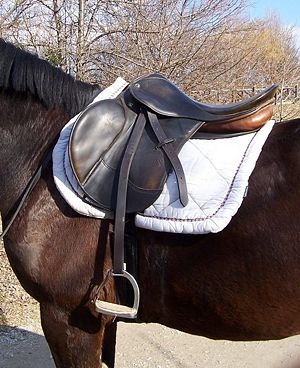Horse/Choosing a horse: Difference between revisions
imported>Nancy Sculerati MD mNo edit summary |
imported>Nancy Sculerati MD No edit summary |
||
| Line 1: | Line 1: | ||
'''Choosing a horse''' involves a larger committment than is involved in any other domestic animal. Horses are long lived, "high-maintainence" creatures that are almost always easier to buy than to sell. | '''Choosing a horse''' involves a larger committment than is involved in obtaining any other common domestic animal. Horses are long lived, "high-maintainence" creatures that are almost always easier to buy than to sell. | ||
=Horse or pony?= | =Horse or pony?= | ||
Revision as of 19:51, 2 February 2007
Choosing a horse involves a larger committment than is involved in obtaining any other common domestic animal. Horses are long lived, "high-maintainence" creatures that are almost always easier to buy than to sell.
Horse or pony?
Age
Breed
Gelding, Mare, or Stallion?
Discipline: what do you want from the horse?
Western or English?
Although Western style riding includes classes in English pleasure, horses trained for that discipline may not be as comfortable with being ridden "on the bit".
Competition
Trail (Hack)
Companion horse
Available facilities: what can you offer the horse?
"Horse traders"- Caveat emptor!
Where can a horse be obtained?
Breed Organizations
Trainers
Public sales
Auctions
Rescue horses
In the UK, the RSPCA offers horse adoption [1]
Racehorses
Thoroughbred race horses [2]. Other organizations place a variety of race horses, including standard bred pacers [3]
How can a horse be properly evaluated?
Avoiding injury
The reality of equestrian activities is that death and serious injury, including permanent paralysis, are not rare events. Such outcomes cannot be entirely prevented by proper training of horse and rider, the correct use of sound equipment in adequate facilities, or by riding only under proper supervision - but they can be readily prompted by any or all of the opposite practices. Horse shopping can be a very dangerous pastime for that reason.
Horses are so expensive to transport that a horse is usually first evaluated at its home facility. Despite what is advertised by the seller, this may be a field or paddock that has poor footing for riding and may even be shared by other horses. This is not a safe place for any amateur to ride a new horse for the first time.
Tack may be supplied by the seller for a trial ride, and that arrangement often has the advantage of a bit and bridle that the horse is accustomed to, rather than a novel arrangement. It is not impolite to double check all aspects of the tack rather than take the word of the seller that "everything is fine". The potential buyer is wise to watch the horse being brought in and being tacked up.
The equestrian who is interested in avoiding catastrophe is generally advised to never ride a horse, no matter how safe and well-trained the animal is said to be, without seeing the horse ridden immediately beforehand by a person who is familiar with it.
Health evaluation
Vet Check
Equine vets around the world routinely perform what is known as a "pre-purchase exam". Certain feautures of this examination, done for pleasure or sport performance horses, are common to most countries and disciplines [4]. The cost of the examination is generally borne by the potential buyer. One reason for this is to avoid a conflict of interest on the part of the vet. Not only is the buyer better off paying for the examination, the buyer is also wise to choose the vet rather than use a vet supplied by the seller's recommendation.
A rider will be required to be present at the time of the vet's examination because the horse will be put through its paces under tack.

